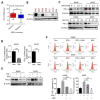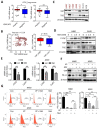Melatonin Downregulates PD-L1 Expression and Modulates Tumor Immunity in KRAS-Mutant Non-Small Cell Lung Cancer
- PMID: 34073318
- PMCID: PMC8199131
- DOI: 10.3390/ijms22115649
Melatonin Downregulates PD-L1 Expression and Modulates Tumor Immunity in KRAS-Mutant Non-Small Cell Lung Cancer
Abstract
Non-small cell lung cancer (NSCLC) patients harboring a KRAS mutation have unfavorable therapeutic outcomes with chemotherapies, and the mutation also renders tolerance to immunotherapies. There is an unmet need for a new strategy for overcoming immunosuppression in KRAS-mutant NSCLC. The recently discovered role of melatonin demonstrates a wide spectrum of anticancer impacts; however, the effect of melatonin on modulating tumor immunity is largely unknown. In the present study, melatonin treatment significantly reduced cell viability accompanied by inducing cell apoptosis in KRAS-mutant NSCLC cell lines including A549, H460, and LLC1 cells. Mechanistically, we found that lung cancer cells harboring the KRAS mutation exhibited a higher level of programmed death ligand 1 (PD-L1). However, treatment with melatonin substantially downregulated PD-L1 expressions in both the presence and absence of interferon (IFN)-γ stimulation. Moreover, KRAS-mutant lung cancer cells exhibited higher Yes-associated protein (YAP) and transcriptional coactivator with PDZ-binding motif (TAZ) levels, and PD-L1 expression was positively correlated with YAP and TAZ in lung cancer cells. Treatment with melatonin effectively suppressed YAP and TAZ, which was accompanied by downregulation of YAP/TAZ downstream gene expressions. The combination of melatonin and an inhibitor of YAP/TAZ robustly decreased YAP and PD-L1 expressions. Clinical analysis using public databases revealed that PD-L1 expression was positively correlated with YAP and TAZ in patients with lung cancer, and PD-L1 overexpression suggested poor survival probability. An animal study further revealed that administration of melatonin significantly inhibited tumor growth and modulated tumor immunity in a syngeneic mouse model. Together, our data revealed a novel antitumor mechanism of melatonin in modulating the immunosuppressive tumor microenvironment by suppressing the YAP/PD-L1 axis and suggest the therapeutic potential of melatonin for treating NSCLC.
Keywords: Hippo pathway; PD-L1; lung cancer; melatonin; tumor immunity.
Conflict of interest statement
The authors declare no conflict of interest.
Figures





Similar articles
-
KRAS-G12D mutation drives immune suppression and the primary resistance of anti-PD-1/PD-L1 immunotherapy in non-small cell lung cancer.Cancer Commun (Lond). 2022 Sep;42(9):828-847. doi: 10.1002/cac2.12327. Epub 2022 Jul 11. Cancer Commun (Lond). 2022. PMID: 35811500 Free PMC article.
-
Efficacy of Immune Checkpoint Inhibitors in KRAS-Mutant Non-Small Cell Lung Cancer (NSCLC).J Thorac Oncol. 2019 Jun;14(6):1095-1101. doi: 10.1016/j.jtho.2019.01.011. Epub 2019 Feb 6. J Thorac Oncol. 2019. PMID: 30738221
-
The superior efficacy of anti-PD-1/PD-L1 immunotherapy in KRAS-mutant non-small cell lung cancer that correlates with an inflammatory phenotype and increased immunogenicity.Cancer Lett. 2020 Feb 1;470:95-105. doi: 10.1016/j.canlet.2019.10.027. Epub 2019 Oct 20. Cancer Lett. 2020. PMID: 31644929
-
Epidermal Growth Factor Receptor (EGFR) Pathway, Yes-Associated Protein (YAP) and the Regulation of Programmed Death-Ligand 1 (PD-L1) in Non-Small Cell Lung Cancer (NSCLC).Int J Mol Sci. 2019 Aug 5;20(15):3821. doi: 10.3390/ijms20153821. Int J Mol Sci. 2019. PMID: 31387256 Free PMC article. Review.
-
Immune checkpoint inhibitors in epidermal growth factor receptor mutant non-small cell lung cancer: Current controversies and future directions.Lung Cancer. 2018 Jan;115:12-20. doi: 10.1016/j.lungcan.2017.11.009. Epub 2017 Nov 13. Lung Cancer. 2018. PMID: 29290252 Review.
Cited by
-
Histone deacetylases modulate resistance to the therapy in lung cancer.Front Genet. 2022 Oct 3;13:960263. doi: 10.3389/fgene.2022.960263. eCollection 2022. Front Genet. 2022. PMID: 36263432 Free PMC article. Review.
-
Melatonin suppresses PD-L1 expression and exerts antitumor activity in hepatocellular carcinoma.Sci Rep. 2025 Mar 11;15(1):8451. doi: 10.1038/s41598-025-93486-4. Sci Rep. 2025. PMID: 40069331 Free PMC article.
-
Melatonin Attenuates Dextran Sodium Sulfate Induced Colitis in Obese Mice.Pharmaceuticals (Basel). 2021 Aug 21;14(8):822. doi: 10.3390/ph14080822. Pharmaceuticals (Basel). 2021. PMID: 34451919 Free PMC article.
-
Multi-omics landscape of circadian rhythm pathway alterations in Glioma.Bioengineered. 2021 Dec;12(1):3294-3308. doi: 10.1080/21655979.2021.1947075. Bioengineered. 2021. PMID: 34224318 Free PMC article.
-
Establishment and clinical value of a circulating tumor cell system based on a multi-site immune lipid magnetic sphere technique in laryngopharyngeal head and neck tumors.Am J Cancer Res. 2025 Jan 15;15(1):19-31. doi: 10.62347/MVRG3697. eCollection 2025. Am J Cancer Res. 2025. PMID: 39949932 Free PMC article.
References
-
- Lee C.K., Man J., Lord S., Cooper W., Links M., Gebski V., Herbst R.S., Gralla R.J., Mok T., Yang J.C. Clinical and Molecular Characteristics Associated With Survival Among Patients Treated With Checkpoint Inhibitors for Advanced Non-Small Cell Lung Carcinoma: A Systematic Review and Meta-analysis. JAMA Oncol. 2018;4:210–216. doi: 10.1001/jamaoncol.2017.4427. - DOI - PMC - PubMed
MeSH terms
Substances
Grants and funding
LinkOut - more resources
Full Text Sources
Medical
Research Materials
Miscellaneous

